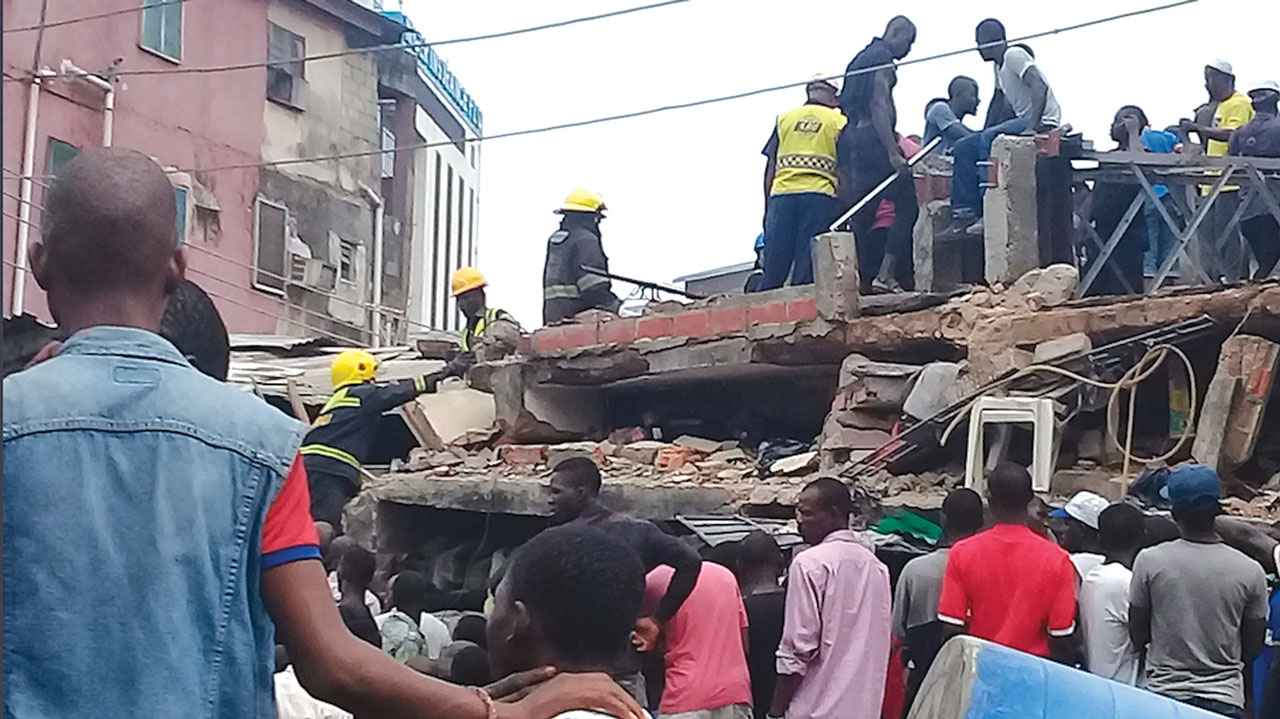AT 7:30 a.m. on Tuesday, October 28, 2025, No. 43/45, Coates Street, Oyingbo, Ebute-Metta, Lagos was a hive of tense activity. Excavators stood poised to resume the search for survivors or more bodies. Every new building collapse is a dirge in the advocacy expedition of the Building Collapse Prevention Guild (BCPG). Each incident reopens old wounds, deepening a tragedy we have warned against for years.
One should not wait for personal experience before one realises the enormity of the danger building collapse has hung, like an albatross, around the Nigerian built environment. If this menace is not seriously addressed, a visitor to a building, even a passer-by, can become a victim.
The tolerance of a system that accommodated all comers affairs in building production and construction processes has led to the existence of feeble buildings.Ebute-Metta area of the Lagos Mainland Local Government has long been designated the haven of substandard building construction done by all sorts of developers. The government responded by assigning the Lagos State Materials Testing Laboratory to conduct non-destructive tests on some of the suspected weak buildings. The distressed ones were identified, conspicuously marked red, and slated for demolition by the Lagos State Building Control Agency (LABSCA).
In this part of the world, driving rain has become a veritable instrument for testing the stability of the building.
Mobilising leaders of the built environment professional bodies and the leadership of building artisans, I led a large delegation under the aegis of the Building Collapse Prevention Guild to the palace of Oba of Lagos, HRM Riliwan Akiolu on Tuesday, November 10, 2015. Representatives of BCPG Lagos Island Cell led by Tpl. Hakeem Bishi (:a town planner) and Bldr. Mubarak Gbaja – Biamila ( a builder) welcomed us to their domain.
The challenges of developers and allied issues of building collapse were presented to the Kabiyesi and the white cap chiefs. In unison, the Brazilian emancipados were eulogized for constructing buildings that stood the test of time on Lagos Island and its environs. For instance, Mr. Candido Da Rocha’s two-storey building, popularly known as Water House on Kakawa Street, Lagos Island, remained firm since 1875 when it was built. On the contrary, buildings developed based on a built – operate – transfer model might become distressed before the 20 – to 30 – year agreement elapsed. The need to take a tough stance against developers of substandard buildings was unanimously echoed. The traditional chiefs were charged to caution families to examine the capacity of prospective developers before handing over their inheritance for redevelopment into multi-storey buildings.
Lessons learnt from this meeting helped define a new approach. The existence of housing shortage and the inability of government to make adequate provision brought to fore the entrepreneurial intervention of developers. Since developers were needed to fill the gap, BCPG began to engage ethically and technically those developers that decided to come together, becoming the ‘Association of Real Estate Developers Of Lagos State (AREDOLS)’
Unfortunately, the difficulty surrounding accessibility and structural verification of suspected feeble buildings in Police Barracks remained untreated.
The collapse of a three-storey building within the premises of Police Barracks at Pedro in Shomolu, Lagos, on Monday, 30th June, 2014, aroused concerns. The Coordinator of BCPG Shomolu Cell, Surv. Mrs. Yemi Ajidahun ( a land surveyor ) led a team to the barracks. The feedback from the assessment team initiated the BCPG visit to the Lagos State Commissioner of Police, Cornelius Kayode Aderanti, at the GRA, Ikeja, on Friday, 16th January, 2015. An audit, subjecting the buildings in the
Police Barracks to structural integrity tests, was recommended. Inadequate maintenance of the buildings was highlighted. Apprehensively, the commissioner established a link between the Technical Department of the Police and BCPG.
Inertia on the identified distressed buildings lingered. Out of the 149 defective or distressed buildings that were identified for demolition by the Lagos State Government across the state, 48 of the buildings were located on Lagos Island. Among them was the five-storey building at No. 63, Massey Street, Ita Faaji, Lagos Island. The cracks on the walls were patched in a continual renovation. Despite the spalling of concrete, the residential building, partially converted to a school, continued to be used.
At about 10 a.m. on Tuesday, March 13, 2019, disaster struck as the building could no longer sustain the loading. All footings lost, the components of the superstructure bowed speedily to disintegration, terminating the lives of over 20 people, mostly pupils, and maiming many.
As a member of the panel that was set up by the Lagos State Government to investigate this pathetic building collapse at Massey Street, I wondered why the lessons learnt in that incident could not prevent the recurrence that brought the same set of government workers to Coates Street on rescue mission.
The explanation being given before me by the survivors of the collapsed building at Coates Street was similar to the one the survivors of the collapsed building at Massey Street gave me. In the face of impending danger, the developers and the tenants were appealing and negotiating allegedly with government officials for extension or cancellation of demolition notice while embarking on renovation.
The narration of the survivors of this latest building collapse in Nigeria reminded me of a video that trended on social media immediately after the collapse of four – storey residential building at 32, Ibadan Street, Ebute-Metta, Lagos on Monday, 2nd May, 2022. In the said video that captured the meeting held by the tenants prior to the collapse, financial constraints could be adduced to their recalciltrance or reluctance to evacuate.
Competence could not be overemphasised in the Nigerian building industry that is beleaguered with building collapse due, mostly, to quackery.
Rising to the challenge of quackery at the theatre, the field of activities, and with the intention of preventing the construction of buildings that might become distressed, the Lagos State House of Assembly under the leadership of Rt. Hon. Mudushiru Obasa, in 2019, made some improvements in the Lagos State Building Control Agency Regulations, which were assented to by the Governor, H.E. Babajide Sanwo-Olu.
Section 4 sub-section 2 of the Regulations stipulates that, ‘ The site execution of every building under construction shall be managed by a registered builder. ‘Added to this section is sub-section 3, which states that, ‘Supervision to ensure that execution of building construction conforms with designs shall be carried out by the architects and engineers. ‘
This should not be considered a privilege or an invitation to a tea party as punishments await incompetence and non- satisfactory performance.
In view of this, section 13, sub – section 5 of the LASBCA Regulations warns that, ‘ In case of defects, failure in such a building, causing its eventual collapse due to negligence, the builder, engineer (s), architect, and developer shall be held liable.’
Really, most problems that prepare grounds for future building collapse are incubated on site. To prevent such inhibitions, the professionals that are assigned the sensitive duties on site must pay attention to details, be vigilant, and be conversant with the appropriate building production process. It is the versatile, rugged, and practical oriented ones that can effectively manage building artisans and the complex interwoven activities of building production process. Dismal performance, against expectations, resulting in distressed building could lead to withdrawal of practising license and, eventually, possible career ruination.
The official collaboration between the Standards Organisation of Nigeria (SON) and the Building Collapse Prevention Guild ( BCPG) should be exploited in addressing the prevalence of substandard building materials.
The modus operandi of BCPG promotes harmonious working relationships among built environment professionals in Nigeria. Such a united front of allied professionals, with each respecting the other professionals’ areas of specialisation, is appropriately equipped to attenuate the menace of building collapse.
The common denominator in the enumerated incidents, which is renovation of confirmed distressed buildings, is a practice that the BCPG has long been cautioning against. Cosmetic treatment to buildings that are structurally deficient is counter-productive.
This retrogressive cycle is driven by two forces. The first is economic desperation. A developer tied to a build-operate-transfer agreement with the landowner fears financial loss and seeks to extend the lifespan of a condemned building at all cost. The second is
occupants’ resistance, fueled by the scarcity of affordable housing in high-demand urban centres. These pressures often combine with weak enforcement and the lure of revenue generation from offence penalties to produce discreet compromises, with deadly consequences.
The way forward is clear. The government should expedite action on building condition surveys that include structural appraisal of existing buildings, especially buildings erected by uncertified developers. The price of Non – Destructive – Tests should be made affordable. The government should provide transit camps or temporary relocation shelters for occupants of distressed buildings. Deconstruction or demolition of structurally distressed buildings must not be delayed.
The government needs the essential political will to overcome influence peddling and sentiments that do arise in the process of building demolition decisions and the execution. The importance of insurance can not be overemphasised, considering the need to provide compensation for victims of collapsed buildings. Developers should be encouraged to register with the federal government initiated Real Estate Developers Association of Nigeria ( REDAN) and get examined for proper accreditation. Most importantly, buildings must be constructed correctly from the outset because preventing failure is far easier and cheaper than managing collapse.
A change in people’s negative attitude towards compliance will make the robust extant building regulations less undermined during implementation.When the pendulum of the distressed building swings between demolition and renovation, the regulators must overcome inertia and be decisive.
Compliance must cease to be negotiable. Building regulations, no matter how well written, are meaningless unless the society respects them. We can not plaster over structural decay. We can not paint away danger. We can not continue to bury citizens from preventable tragedies. Until we confront this reality, the ground beneath us will continue to betray us. Lives will continue to be lost – not to fate, but to negligence disguised as renovation.
• Awobodu is the Pioneer National President, Building Collapse Prevention Guild ( BCPG), and Past National President, Nigerian Institute of Building ( NIOB)






